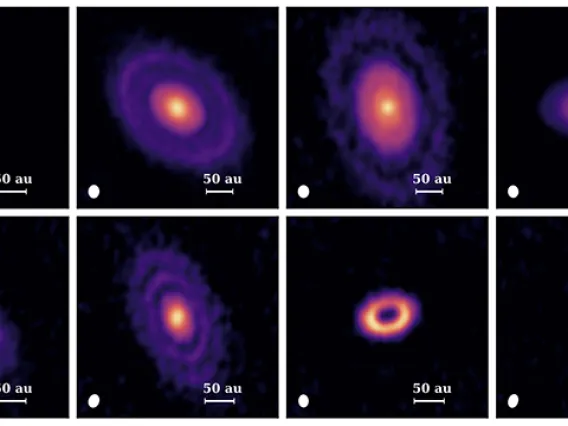
Unknown Treasure Trove of Planets Found Hiding in Dust
The first unbiased survey of protoplanetary disks surrounding young stars in the Taurus star-forming region turned up a higher-than-expected number of disks with features suggesting nascent planets.Unknown Treasure Trove of Planets Found Hiding in Dust
×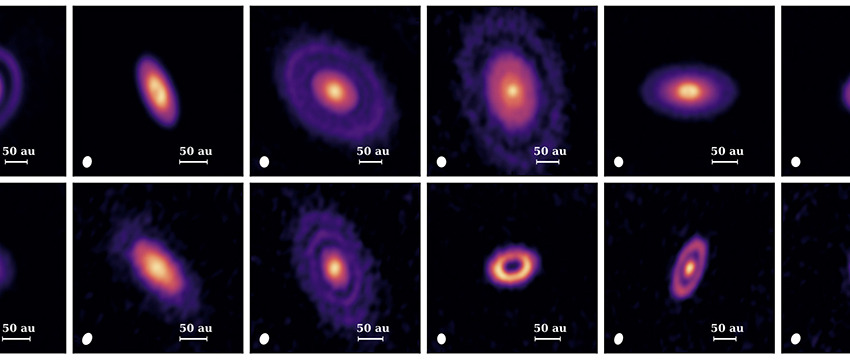
By Daniel Stolte, University Communications - December 6, 2018
"Super-Earths" and Neptune-sized planets could be forming around young stars in much greater numbers than scientists thought, new research by an international team of astronomers suggests.
Observing a sampling of young stars in a star-forming region in the constellation Taurus, researchers found many of them to be surrounded by structures that can best be explained as traces created by invisible, young planets in the making. The research, published in the Astrophysical Journal, helps scientists better understand how our own solar system came to be.
Some 4.6 billion years ago, our solar system was a roiling, billowing swirl of gas and dust surrounding our newborn sun. At the early stages, this so-called protoplanetary disk had no discernable features, but soon, parts of it began to coalesce into clumps of matter – the future planets. As they picked up new material along their trip around the sun, they grew and started to plow patterns of gaps and rings into the disk from which they formed. Over time, the dusty disk gave way to the relatively orderly arrangement we know today, consisting of planets, moons, asteroids and the occasional comet.
Scientists base this scenario of how our solar system came to be on observations of protoplanetary disks around other stars that are young enough to currently be in the process of birthing planets. Using the Atacama Large Millimeter Array, or ALMA, comprising 45 radio antennas in Chile's Atacama Desert, the team performed a survey of young stars in the Taurus star-forming region, a vast cloud of gas and dust located a modest 450 light-years from Earth. When the researchers imaged 32 stars surrounded by protoplanetary disks, they found that 12 of them – 40 percent – have rings and gaps, structures that according to the team's measurements and calculations can be best explained by the presence of nascent planets.
"This is fascinating because it is the first time that exoplanet statistics, which suggest that super-Earths and Neptunes are the most common type of planets, coincide with observations of protoplanetary disks," said the paper's lead author, Feng Long, a doctoral student at the Kavli Institute for Astronomy and Astrophysics at Peking University in Bejing, China.
While some protoplanetary disks appear as uniform, pancake-like objects lacking any features or patterns, concentric bright rings separated by gaps have been observed, but since previous surveys have focused on the brightest of these objects because they are easier to find, it was unclear how common disks with ring and gap structures really are in the universe. This study presents the results of the first unbiased survey in that the target disks were selected independently of their brightness – in other words, the researchers did not know whether any of their targets had ring structures when they selected them for the survey.
"Most previous observations had been targeted to detect the presence of very massive planets, which we know are rare, that had carved out large inner holes or gaps in bright disks," said the paper's second author Paola Pinilla, a NASA Hubble Fellow at the University of Arizona's Steward Observatory. "While massive planets had been inferred in some of these bright disks, little had been known about the fainter disks."
The team, which also includes Nathan Hendler and Ilaria Pascucci at the UA's Lunar and Planetary Laboratory, measured the properties of rings and gaps observed with ALMA and analyzed the data to evaluate possible mechanisms that could cause the observed rings and gaps. While these structures may be carved by planets, previous research has suggested that they may also be created by other effects. In one commonly suggested scenario, so-called ice lines caused by changes in the chemistry of the dust particles across the disc in response to the distance to the host star and its magnetic field create pressure variations across the disk. These effects can create variations in the disk, manifesting as rings and gaps.
The researchers performed analyses to test these alternative explanations and could not establish any correlations between stellar properties and the patterns of gaps and rings they observed.
"We can therefore rule out the commonly proposed idea of ice lines causing the rings and gaps," Pinilla said. "Our findings leave nascent planets as the most likely cause of the patterns we observed, although some other processes may also be at work."
Since detecting the individual planets directly is impossible because of the overwhelming brightness of the host star, the team performed calculations to get an idea of the kinds of planets that might be forming in the Taurus star-forming region. According to the findings, Neptune-sized gas planets or so-called super-Earths – terrestrial planets of up to 20 Earth masses – should be the most common. Only two of the observed disks could potentially harbor behemoths rivaling Jupiter, the largest planet in the solar system.
"Since most of the current exoplanet surveys can't penetrate the thick dust of protoplanetary disks, all exoplanets, with one exception, have been detected in more evolved systems where a disk is no longer present," Pinilla said.
Going forward, the research group plans to move ALMA's antennas farther apart, which should increase the array's resolution to around five astronomical units (one AU equals the average distance between the Earth and the sun), and to make the antennas sensitive to other frequencies that are sensitive to other types of dust.
"Our results are an exciting step in understanding this key phase of planet formation," Long said, "and by making these adjustments, we are hoping to better understand the origins of the rings and gaps.”
This work was made possible through an international collaboration, including astronomers at UA's Steward Observatory and LPL. For a complete list of authors and funding information, please see the paper, "Gaps and Rings in an ALMA Survey of Disks in the Taurus Star-forming Region." A preprint of the article is available at https://arxiv.org/abs/1810.06044. Funding for this project was provided by Peking University, National Science Foundation of China, the Hubble Fellowship Program, the National Science Foundation, and the Earths in Other Solar Systems Nexus for Exoplanetary System Science program.
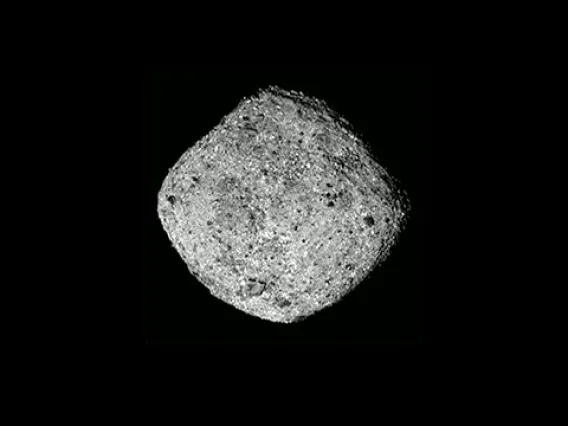
OSIRIS-REx Arrives at Asteroid Bennu
Since its launch on Sept. 8, 2016, OSIRIS-REx has spent two years catching up with asteroid Bennu on its orbit around the sun. The spacecraft's arrival at Bennu on Dec. 3 marks a major milestone, with the mission transitioning from flying toward the asteroid to orbiting around it.OSIRIS-REx Arrives at Asteroid Bennu
×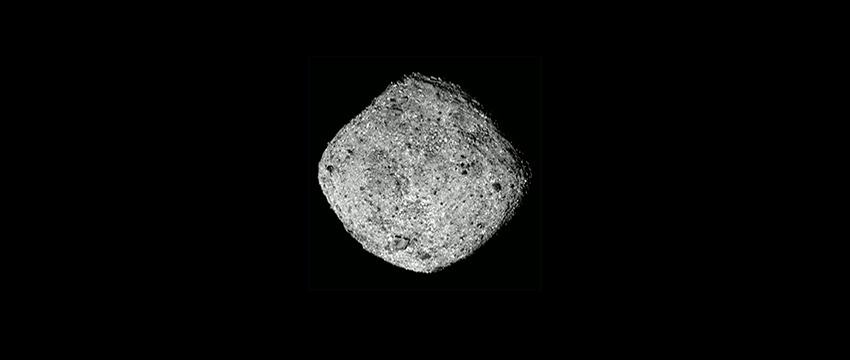
By Daniel Stolte, University Communications - December 4, 2018
NASA’s OSIRIS-REx spacecraft arrived at its destination, asteroid Bennu, on Dec. 3. Led by the University of Arizona, the OSIRIS-REx mission is the first NASA mission to visit a near-Earth asteroid, survey the surface, collect a sample and deliver it safely back to Earth. The composition of the asteroid, Bennu, could shed more light on the origins of the solar system.
"Initial data from the approach phase show this object to have exceptional scientific value. We can't wait to get to work studying and characterizing Bennu's rough and rugged surface to find out where the right spot is to collect the sample and bring it back to Earth," said Dante Lauretta, the mission's principal investigator. "Today has been very exciting, but the true nail-biting moment will be the sample collection. The best times are ahead of us, so stay tuned. The exploration of Bennu has just begun, and we have a lifetime of adventure ahead of us."
OSIRIS-REx will spend the next month performing flybys of Bennu's north pole, equator and south pole, at distances ranging between 11.8 and 4.4 miles from the asteroid. These maneuvers will allow for the first direct measurement of Bennu's mass, as well as close-up observations of the surface. These trajectories will also provide the mission's navigation team with experience navigating near the asteroid.
The spacecraft will then spend the next 18 months extensively surveying the asteroid before the mission team identifies two possible sample sites. The spacecraft will study the asteroid with various instruments, providing mission scientists with a wealth of data about the asteroid's exact shape, chemical composition and physical properties influencing how it is affected by the sun and the surrounding space.
Sample collection is scheduled for July 2020, when OSIRIS-REx will ultimately touch the surface for five seconds to gather a sample of the asteroid. The spacecraft will head back toward Earth before ejecting the Sample Return Capsule for landing in the Utah desert on September 24, 2023.
"Working on this mission has been probably the most life-changing event that has happened to me so far," said UA senior Keara Burke, a systems engineering and mathematics double major who is helping the mission team find the perfect place to collect samples. "It's incredible to be able go to work every day and know that what I'm contributing to the conversation matters. Being able to be part of this type of mission – I don't think I would have gotten this opportunity anywhere else."
The UA leads the OSIRIS-REx mission on behalf of NASA. All science operations of the mission are housed at and led by UA's Lunar and Planetary Laboratory, where all science data gathered by the spacecraft are received and analyzed. More than 150 students, both at undergraduate and graduate level, have been working on the mission so far.
"It is really exciting to arrive at the asteroid that our team has been tracking now for a couple of years, and to see one of our students being so intimately involved in this project," UA President Robert C. Robbins said of Burke. "I think this highlights the fact that we are the place that not only does this kind of research, but also educates the next generations of leaders in this field."
OSIRIS-REx stands for Origins, Spectral Interpretation, Resource Identification, Security-Regolith Explorer. The economic impact to Arizona of the OSIRIS-REx mission is $230.5 million. Of that, $172.3 million comes to Tucson.
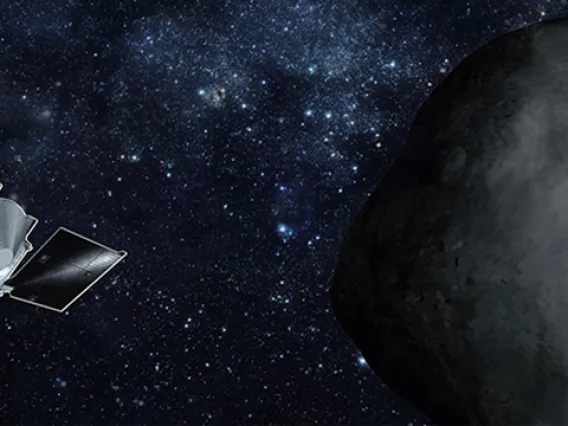
We're at Bennu! What's Next?
The LPL-led OSIRIS-REx mission kicks into high gear while the spacecraft is on its final approach, closing in on asteroid Bennu and scheduled for arrival on Dec. 3. UA mission experts explain what comes next.We're at Bennu! What's Next?
×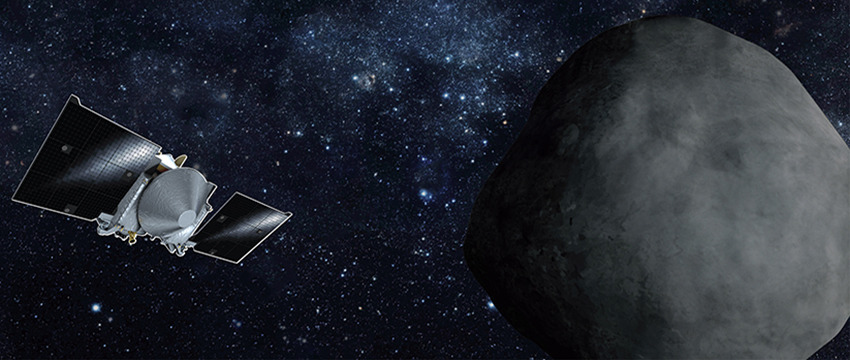
By Daniel Stolte, University Communications - November 29, 2018
Since it launched on Sept. 8, 2016, the spacecraft of the University of Arizona-led OSIRIS-REx asteroid sample return mission has been catching up with its destination, asteroid Bennu, on its trip around the sun. On Dec. 3, the spacecraft is scheduled for arrival. UANews asked mission experts about what lies ahead for the robotic explorer and its human companions here on Earth.
Once OSIRIS-REx arrives at Bennu, why will have to stay in orbit for two years before going for the sampling?
Dante Lauretta, OSIRIS-REx Principal Investigator: The OSIRIS-REx spacecraft will enter orbit around Bennu by moving at a very slow velocity, relative to the asteroid, on the order of 4 inches (10 centimeters) per second. To accomplish this feat, we must characterize the mass, shape and rotation state of the asteroid. Fortunately, the equations for orbital stability hold even for a very low mass object like Bennu. The challenge lies in the fact that other forces acting on the spacecraft, such as solar radiation pressure, spacecraft outgassing and thermal radiation, are of the same order of magnitude as Bennu’s gravity. The team must perform regular optical navigation-based orbit determination. This process is not required to keep us in orbit. Instead, it is needed for us to understand where in the orbit we are. Although small, these forces can move the spacecraft by as much as 180 degrees along its track within a few short days. If we lost track of the spacecraft position in orbit, we would not know where to point the science instruments to collect our data.
Christian Drouet d'Aubigny, OSIRIS-REx Camera Suite Deputy Instrument Scientist: We need to know exactly where we are with respect to Bennu. To an astronaut, it would be obvious: "The asteroid is over there and all I have to do is point the camera." But with a robot, it's always a challenge. The spacecraft knows exactly where it is with respect to stars, because it knows the constellations it sees with great precision, but it doesn't know exactly where it is with respect to Bennu. When we plan our operations, weeks ahead of time, we have to take into account that when we execute the observation, the spacecraft position with respect to Bennu won’t be known exactly. The spacecraft’s own knowledge of where it is located is based on observations that are at least a day old. It knows where it should be based on where it was yesterday.
Bashar Rizk, OSIRIS-REx Camera Suite Instrument Scientist: We don't have all the information we need to successfully and safely take a sample from the asteroid at this time. We have given ourselves enough time and margin to gather all the information we need to be able to analyze and chew on that information so it can successfully inform the next step in the process.
How does the spacecraft stay in orbit around Bennu?
Rizk: Driving a spacecraft around an object like Bennu is a fine art, and we're learning it as we go along. Unlike a spacecraft that orbits a planet such as Mars, the relative velocities are not high – we are crawling along – but because the gravitational forces are so weak, other effects begin to matter. Our spacecraft is constantly exposed to solar pressure and thermal asymmetry: whichever side happens to be facing the sun gets warmer and emits its own thermal radiation. That radiation carries momentum – a very slight momentum, but given enough time, it is going to make itself felt. In addition, you have the effects of the micro-thrusting maneuvers that help us move around. So far, every aspect about this object has been very successfully predicted, so we have high hopes, but there is no denying that there are challenges.
What "eyes" does the spacecraft use to see and study the asteroid?
d'Aubigny: The spacecraft has three science cameras – all were built here at the University of Arizona – PolyCam, MapCam and SamCam, plus a suite of wide-angle cameras made by Malin Space Science Systems for Lockheed Martin that are used for navigation. When the asteroid still was far away, we used PolyCam to acquire the first images from 1.2 million miles (2 million kilometers) away because it is the most sensitive of all the OSIRIS-REx cameras. On Nov. 15, when the spacecraft was only 75 miles (120 km) from Bennu, we switched to MapCam. We are progressively switching from higher magnification and narrower field of view to lower magnification and a wider field of view. It's similar to what you would do with an optical zoom lens, but done with different cameras. MapCam and PolyCam will be used to study the asteroid from up close. MapCam is going to map Bennu's surface. As we go past the asteroid and see different parts, we will point the spacecraft in various directions, take mosaic images and stitch them together. We'll go through different phases, getting progressively closer to Bennu, starting from 12.4 miles (20 km) and getting into orbit as close as .9 mile (1.5 km) from the asteroid. The closest approach will be is when we do our reconnaissance passes at 656 feet (200 meters) above the surface. The images with the highest resolution will be taken by PolyCam, which will serve as our high-power telephoto lens. At closest approach, the field of view comes down to a 10-foot-by-10-foot (3 m) square, or approximately the size of a bedroom, and with enough resolving power we could see a pea on a table. Using MapCam, which has not quite the high resolution and magnification of PolyCam, we're going to map the whole surface down to a scale of one-quarter of a meter (.82 feet), about the size of a soccer ball.
How will you prepare for the sampling?
d'Aubigny: Based on the images and combined information from all the instruments, such as LIDAR and the spectrometers, we will narrow down the search for sites that are interesting from a science standpoint, have the surface with material of the size we need for sampling and are free of hazards. We have to focus on up to five sites, we will image those with really high resolution with PolyCam from orbit, but also as we narrow down that list, at some point we will have just two – a primary and a secondary samples site – and that is where we will do the close reconnaissance passes.
Dani DellaGiustina, Lead Image Processing Scientist: The first thing we need to do before we can start mapping the surface and finding anything that could pose a hazard to the sampling mechanism is to relate the images taken by our cameras to the shape model of the asteroid. To do this, we take the images and map them into something that is similar to Google Earth, a special framework on which we can co-locate the features. We take two approaches to mapping out hazards: one is old-fashioned counting. Keara Burke, a UA undergraduate student who has taken the initiative to develop software for this project, is leading that work. Her team will count boulders on Bennu's surface. The other is using a crowdsourcing effort: we want to triage the areas that look really smooth and map them out. For this, we are partnering with CosmoQuest, a citizen science program. Early next year, we're going to launch "Bennu Mappers," which will enable citizen scientists to help OSIRIS-REx map the locations and the sizes of all the boulders on Bennu. We define any boulder that is bigger than 8.3 inches (21 cm) as a hazard, because that is the width of the inner chamber of our sampling mechanism and it could become clogged. When we've gotten to the point where we've mapped the surface to where we have narrowed down two potential sampling sites, we will look at cobbles and pebbles while searching for anything as small as .8 inch (2 cm). Particles that size or smaller are easily ingested by our sampling mechanism.

UA Ranked in Top 25 for Research Funding
The UA's strengths in physical sciences and NASA funding make it one of the top research universities in the country, according to the Higher Education Research and Development survey recently released by the NSF.
UA Ranked in Top 25 for Research Funding
×
By Lucio Guerrero, UA Research, Discovery & Innovation - November 21, 2018
With $622 million in research activity in fiscal year 2017, the University of Arizona ranked as one of the top 25 largest research universities among all public institutions, according to data released Tuesday by the National Science Foundation.
The NSF's Higher Education Research and Development survey ranks more than 900 colleges and universities based on their research and development expenditures. It is viewed as the primary source of information on R&D expenditures at U.S. colleges and universities.
In the latest survey, the UA ranks 23rd among all public universities – the highest among Arizona institutions – and 38th among all U.S. universities, both public and private.
The UA's $622 million in R&D expenditures in fiscal year 2017 surpassed the previous year's total by nearly $20 million and put the UA among the top 5 percent of all universities nationwide.
"University of Arizona researchers have had great success over the past year, both in their efforts to attract funding for their work and in the impact that they have in Arizona and globally," said UA President Robert C. Robbins. "UA research is the foundation of our transformational student experience, and I am proud of this result, particularly our standing among Hispanic-Serving Institutions. This ranking is great recognition for the quality and promise of UA research, and I am also eager for the continued strides we will make towards our goals."
The HERD survey also found that the UA is the second largest research university nationwide among schools with high Hispanic enrollment. The university earned the designation of Hispanic-Serving Institution from the U.S. Department of Education for its success in the enrollment of Hispanic students and in providing educational opportunities to them.
The survey also showed that the UA was No. 5 in NASA funding among all universities (up from No. 8 in 2016) and No. 6 in physical sciences R&D expenditures nationwide. UA remained No. 1 among all universities in astronomy and astrophysics R&D.
"UA research is always on the move. Our researchers continue to drive us forward through innovative solutions, meaningful collaborations and impactful discoveries," said Kimberly Ogden, interim vice president for research at the UA. "The quality of our research is recognized around the world and it's because of the dedication and quality of our staff and faculty."
Some of the UA research that made headlines and had significant impact in fiscal year 2017 included:
- The UA Cancer Center was recognized for its multidisciplinary cancer research and research-driven clinical care through a highly competitive grant award from the National Cancer Institute. The NCI renewed the center's status as a Comprehensive Cancer Center and awarded a five-year, $17.6 million Cancer Center Support Grant, based on the strength, depth and breadth of basic laboratory, clinical, prevention, control and population-based research.
- NASA selected to fund the UA-led GUSTO mission, a $40 million endeavor is to send a balloon to near-space carrying a telescope that will study the interstellar medium – the gas and dust between the stars, from which all stars and planets originate.
- The UA is part of a multicampus program awarded a five-year U.S. Department of Transportation grant expected to be worth up to $15.6 million to help transform research, education and outreach related to the nation's pressing transportation issues.
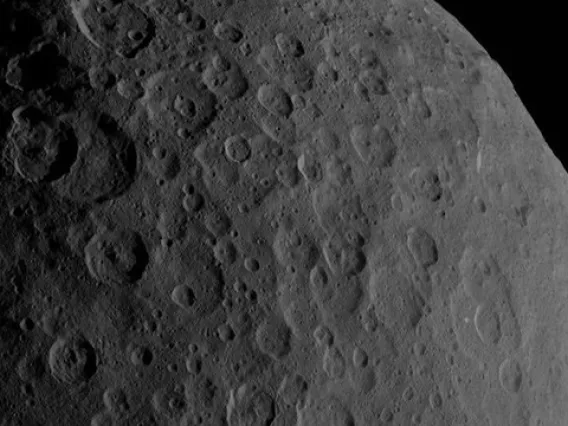
Ceres Takes Life an Ice Volcano at a Time
By Emily Walla, NASACeres Takes Life an Ice Volcano at a Time
×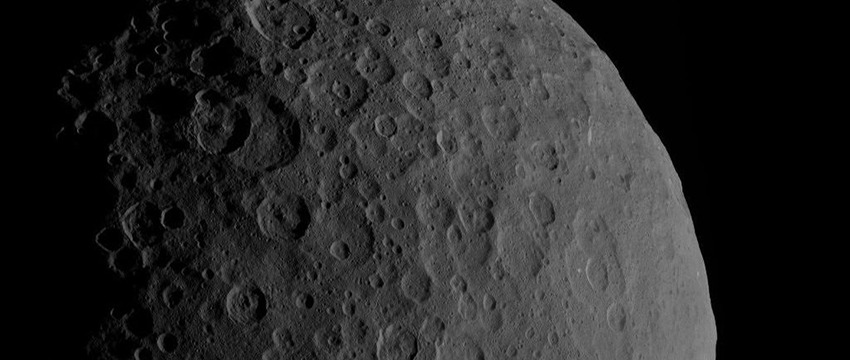
By Emily Walla, NASA Intern/University Communications - September 14, 2018
Every year throughout its 4.5-billion-year life, ice volcanoes on the dwarf planet Ceres generate enough material on average to fill a movie theater, according to a new study led by the University of Arizona.
The study, led by UA planetary scientist Michael Sori, marks the first time a rate of cryovolcanic activity has been calculated from observations, and its findings help solve a mystery about Ceres’s missing mountains.
Discovered 2015 by NASA’s Dawn spacecraft, the 3-mile-tall ice volcano Ahuna Mons rises in solitude over the surface of Ceres. Still geologically young, the mountain is at most 200 million years old, meaning that – though it is no longer erupting – it was active in the recent past.
Ahuna Mons' youth and loneliness presented a mystery. It seemed unlikely Ceres had lain dormant for eons and suddenly erupted in one place. But if other ice volcanoes had risen out of the Cerean surface in ages past, where are those volcanoes now? Why is Ahuna Mons so alone?
Sori and his co-authors, including fellow UA scientist Ali Bramson and professor of planetary science Shane Byrne, sought to answer these questions.
In a paper published last year, they theorized that evidence of older volcanoes on the dwarf planet had been erased over time by a natural process called "viscous relaxation." Viscous materials, like honey or putty, can begin as a thick blob, but the weight of the blob causes it to ooze into a flatter shape over time.
"Rocks don’t do that under normal temperatures and timescales, but ice does," Sori said.
Because Ceres is made of both rock and ice, Sori pursued the theory that formations on the dwarf planet flow and move under their own weight, similar to how glaciers move on Earth. The formations' composition and temperature would affect how quickly they relax into the surrounding landscape. The more ice in a formation, the faster it flows; the lower the temperature, the slower it flows.
Though Ceres never grows warmer than -30 degrees Fahrenheit, the temperature varies across its surface.
"Ceres’ poles are cold enough that if you start with a mountain of ice, it doesn’t relax," Sori said. "But the equator is warm enough that a mountain of ice might relax over geological timescales."
Computer simulations showed that Sori's theory was viable. Model cryovolcanoes at the poles of Ceres remained frozen in place for eternity. At other latitudes on the dwarf planet, model volcanoes began life tall and steep, but grew shorter, wider and more rounded as time passed.
To prove the computer simulations had played out in reality, Sori scoured topographic observations from the Dawn spacecraft, which has been orbiting Ceres since 2015, to find landforms that matched the models.
Across the 1 million square miles of Cerean surface, Sori and his team found 22 mountains including Ahuna Mons that looked exactly like the simulation’s predictions.
"The really exciting part that made us think this might be real is that we found only one mountain at the pole," Sori said.
Though it is old and battered by impacts, the polar mountain, dubbed Yamor Mons, has the same overall shape as Ahuna Mons. It is five times wider than it is tall, giving it an aspect ratio of 0.2. Mountains found elsewhere on Ceres have lower aspect ratios, just as the models predicted: they are much wider than they are tall.
By matching the real mountains to the model mountains, Sori was able to determine the age of many of them. The volume of the volcanoes was estimated by studying their topography, and by combining age and volume, Sori’s team was able to calculate the rate at which cryovolcanoes form on Ceres.
"We found that one volcano forms every 50 million years," Sori said.
This amounts to an average of more than 13,000 cubic yards of cryovolcanic material each year – enough to fill a movie theater or four Olympic-sized swimming pools. This is much less volcanic activity than what is seen on Earth, where rocky volcanoes generate more than 1 billion cubic yards of material in a year.
In addition to being less productive, volcanic eruptions on Ceres are tamer than those on Earth. Instead of explosive eruptions, cryovolcanoes create the icy equivalent of a lava dome: the cryomagma – a salty mix of rocks, ice and other volatiles such as ammonia – oozes out of the volcano and freezes on the surface. Most of the once-mighty cryovolcanoes on Ceres likely formed this way before they relaxed away.
The causes of cryovolcanic eruptions on Ceres are still a mystery, but future research might yield answers, as signs of ice volcanoes have been spotted on other bodies in the solar system as probes have flown by. Ceres is the first cryovolcanic body a mission has orbited, but Europa and Enceladus, moons of Jupiter and Saturn, are likely candidates for cryovolcanism, as are Pluto and its moon Charon. Europa is of special interest because it is believed to have liquid oceans trapped below a thick icy shell, which some scientists believe to be dotted with ice volcanoes.
"There might be similarities between Europa and Ceres, but we need to send the next mission there before we can say for sure," Sori said.
As scientists explore other potentially cryovolcanic bodies in the solar system, it will be fun, Sori said, to see how Ceres compares.
The paper, "Cryovolcanic rates on Ceres revealed by topography," was recently published in Nature Astronomy. Funding was provided by the National Aeronautics and Space Administration (NASA) Dawn Guest Investigator Program.
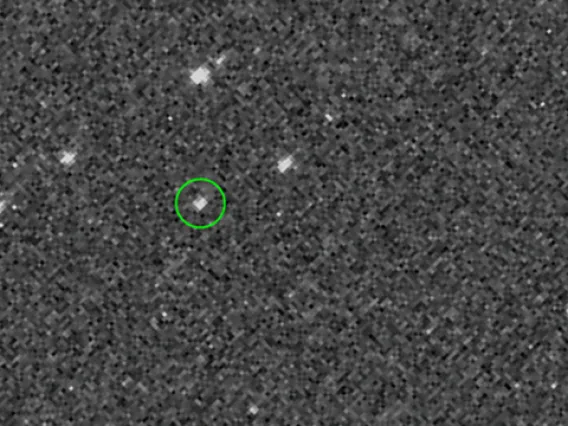
OSIRIS-REx Captures First Glimpse of Asteroid Bennu
By Daniel StolteOSIRIS-REx Captures First Glimpse of Asteroid Bennu
×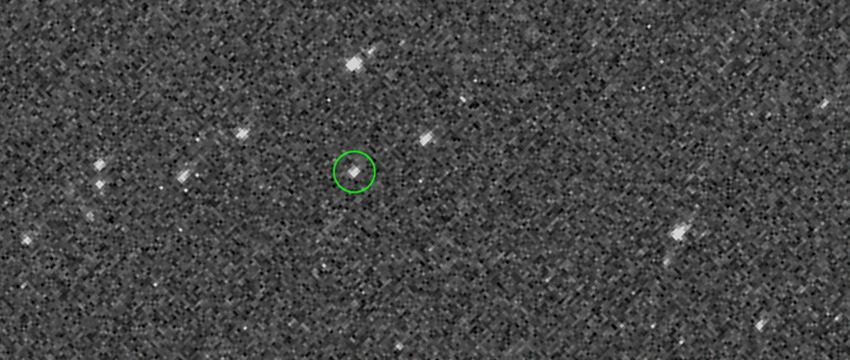
By Daniel Stolte, University Communications, and Erin Morton, OSIRIS-REx - August 24, 2018
After an almost two-year journey through space, NASA's asteroid sampling spacecraft, OSIRIS-REx, caught its first glimpse of asteroid Bennu last week and began the final approach toward its target. On Aug. 17, the spacecraft's PolyCam camera obtained the image from a distance of 1.4 million miles.
Led by the University of Arizona's Lunar and Planetary Laboratory, OSIRIS-REx is NASA's first mission to visit a near-Earth asteroid, survey the surface, collect a sample and deliver it safely back to Earth. The spacecraft has traveled approximately 1.1 billion miles since its Sept. 8, 2016 launch, and is scheduled to arrive at Bennu on Dec. 3.
"Now that OSIRIS-REx is close enough to observe Bennu, the mission team will spend the next few months learning as much as possible about Bennu's size, shape, surface features and surroundings before the spacecraft arrives at the asteroid," said Dante Lauretta, OSIRIS-REx principal investigator and professor of planetary science at the UA. "After spending so long planning for this moment, I can't wait to see what Bennu reveals to us."
To boost itself onto Bennu's orbital plane, OSIRIS-REx performed a slingshot maneuver, or gravity assist, around Earth 11 months ago. The craft is now zipping along at almost 32,000 mph relative to Earth, while catching up with Bennu at a little over 1,200 mph relative to the asteroid. The image was acquired using PolyCam, one of three cameras, all developed at the UA, that together comprise the OSIRIS-REx Camera Suite, OCAMS for short.
Polycam, so named because it is poly-functional, has two jobs: one as a long-range acquisition camera, and the second as a reconnaissance camera once the spacecraft gets close to Bennu. Obtaining the first visual of its target asteroid has been meticulously planned since the early development of the mission. According to OCAMS instrument scientist Bashar Rizk, who has been with the OSIRIS-REx team nearly from the beginning in 2006, almost every action that the spacecraft executes is preceded by a nine-week planning process that consists of program development and multiple tests and reviews, before the code is uploaded to the spacecraft via the Deep Space Antenna network.
Once the spacecraft has begun executing a command, there is very little, if any, ground communication involved, Rizk explained, and taking the first image of Bennu was no exception. When OSIRIS-REx reached the pre-determined position on its trajectory and turned on the camera for a series of 30 total exposures, the asteroid was exactly where mission planners predicted it would be weeks earlier.
"It's like a date," Rizk said. "You don't want to be late, and you don't want to be early."
"Right now, Bennu just looks like a star, a point source," said Carl Hergenrother, LPL staff scientist and OSIRIS-REx astronomy working group lead who proposed Bennu as the mission target during the early planning phase when the asteroid was simply known as 1999 RQ36. "That will change in November, when we will begin detailed observations and we'll start seeing craters and boulders. You could say that's when our asteroid will transition from being an astronomical object to an actual geological object."
As OSIRIS-REx approaches the asteroid, the spacecraft will use its science instruments to gather information about Bennu and prepare for arrival. In addition to the OCAMS camera suite, the spacecraft's science payload includes the OTES thermal spectrometer, the OVIRS visible and infrared spectrometer, the OLA laser altimeter and the REXIS X-ray spectrometer.
During the mission's approach phase, OSIRIS-REx will:
- Regularly observe the area around the asteroid to search for dust plumes and natural satellites, and study Bennu's light and spectral properties
- Execute a series of four asteroid approach maneuvers, beginning on Oct. 1, slowing the spacecraft to match Bennu's speed and trajectory
- Jettison the protective cover of the spacecraft's sampling arm in mid-October and subsequently extend and image the arm for the first time in flight
- Use OCAMS to reveal the asteroid's overall shape in late October and begin detecting Bennu's surface features in mid-November.
After arrival at Bennu, the spacecraft will spend the first month performing flybys of Bennu's north pole, equator and south pole, at distances ranging between 11.8 and 4.4 miles from the asteroid. These maneuvers will allow for the first direct measurement of Bennu's mass, as well as close-up observations of the surface. These trajectories will also provide the mission's navigation team with experience navigating near the asteroid.
"Bennu's low gravity provides a unique challenge for the mission," said Rich Burns, OSIRIS-REx project manager at NASA's Goddard Space Flight Center in Greenbelt, Maryland. "At roughly 0.3 miles in diameter, Bennu will be the smallest object that any spacecraft has ever orbited."
The spacecraft will extensively survey the asteroid before the mission team identifies two possible sample sites. Sample collection is scheduled for early July 2020, and the spacecraft will head back toward Earth before ejecting the Sample Return Capsule for landing in the Utah desert in September 2023.
"The story of this asteroid is the story of the solar system," Rizk said. "When we understand Bennu, we will understand something fundamental about our solar system."
NASA's Goddard Space Flight Center provides overall mission management, systems engineering and the safety and mission assurance for OSIRIS-REx. Lauretta is the principal investigator, and the UA also leads the science team and the mission's science observation planning and data processing. Lockheed Martin Space Systems in Denver built the spacecraft and is providing flight operations. Goddard and KinetX Aerospace are responsible for navigating the OSIRIS-REx spacecraft. OSIRIS-REx is the third mission in NASA's New Frontiers Program. NASA's Marshall Space Flight Center in Huntsville, Alabama, manages the agency's New Frontiers Program for its Science Mission Directorate in Washington.
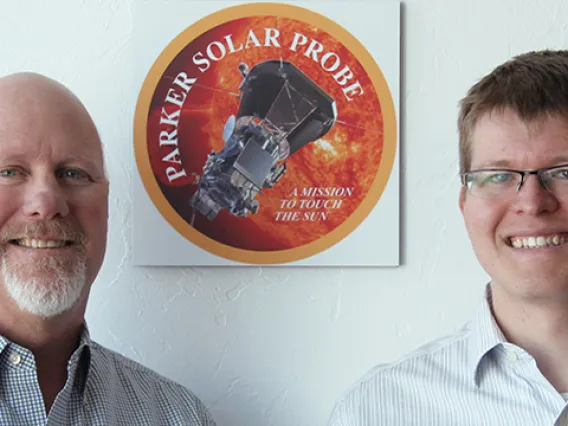
LPL Scientists Gear Up to 'Touch the Sun'
By Daniel StolteLPL Scientists Gear Up to 'Touch the Sun'
×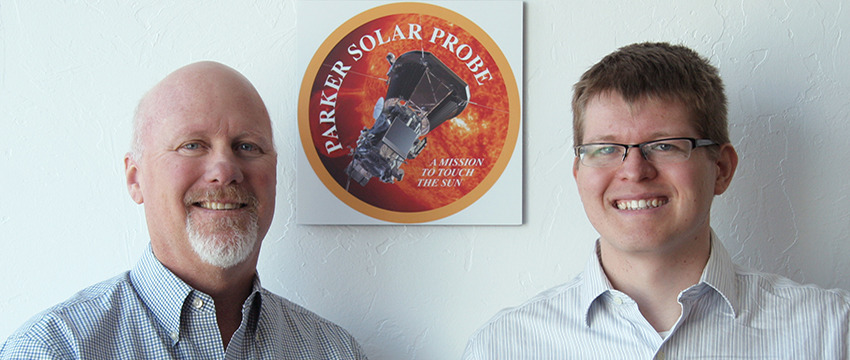
By Daniel Stolte, University Communications - August 8, 2018
Look at any image of the Earth taken from space and chances are you'll find yourself marveling at what looks like the very essence of tranquility.
But the serenity of our blue-swirled marble floating peacefully in the black void is deceiving. The reality is more like that of soccer ball kicked around in a hail storm. The gentle sunshine warming our cheek on a late autumn afternoon is actually a violent affair that, if it wasn't for our planet's protective layers, would instantly kill us.
Earth, and all the other objects in the solar system, plow through what is known as the solar wind – a constant stream of high-energy particles, mostly protons and electrons, hurled into space by the thermonuclear furnace that is our sun.
"If you take all the energy consumed in the U.S. in one year and multiply that by a million, you get the output of the sun in one second. All forms of energy, except for atomic energy, ultimately come from the sun," says Joe Giacalone, a UA professor and astrophysicist who is excited about the upcoming launch of the first-ever mission to "touch the sun."
NASA's Parker Solar Probe, encapsulated in the nose cone of a Delta IV Heavy rocket, is awaiting countdown to liftoff, which is currently scheduled for Aug. 11 at 3:33 a.m. from Kennedy Space Center in Florida. The mission was named after Eugene Parker, the solar astrophysicist who discovered the solar wind, and has been in the works for more than half a century. It was conceived before a space program, or even NASA, existed.
"I was working at the Jet Propulsion Laboratory at the time – in 1956, pre-space age – to work on rockets and things like that," says Marcia Neugebauer, a professor emerita of the UA's Lunar and Planetary Lab. "Sputnik had just happened, and, shortly after, the Explorer program sent the first U.S. satellite into space, so we thought about how to design something to find out if Parker was right or not."
Parker's theory on solar wind was highly debated at the time because no measurements of the actual phenomenon existed. Neugebauer was part of a team who designed a plasma analyzer that flew to Venus on NASA's Mariner-2 spacecraft.
"Our instrument was pointed at the sun, and whenever a positively charged ion entered, we deflected it and counted it," Neugebauer says. "This was before there were particle counters, so we had to measure the change in an extremely weak current, 10 to the minus 12 amperes. It was high-tech at the time."
Parker's prediction proved correct. Now, 60 years later, a spacecraft is bring sent to "directly sample solar particles and magnetic fields in an attempt to resolve some of the most important questions facing the field of solar science today," according to NASA.
The nearest previous observations came from the Helios spacecraft, says Kristopher Klein, who joined the UA's Lunar and Planetary Lab as an assistant professor last year and, like Giacalone, is a co-investigator on the Parker mission. The pair of probes launched in the 1970s have come as close as the orbit of Mercury, the solar system's innermost planet.
"But that doesn't get you into the regions where the acceleration happens," Klein says. "We have seen what is almost the fossilized remains of any activity happening there and had to piece it together by guess. Now, for the first time, we won't have to rely on simulations and something that’s been traveling and processed for two to three days, as is the case for the particles that I mostly study."
Not unlike the more familiar wind in the Earth's atmosphere, the solar wind can be anything from a gentle particle breeze lighting up the Arctic night sky with green-glowing curtains of the Aurora borealis to violent gusts capable of causing global devastation. The last time a solar superstorm blasted our planet was in 1859.
"If that were to happen today, it could cause up to $1 trillion of damage through power grid failures, lost satellites, communication blackouts," Giacalone says. "The sun constantly changes, but we still do not fully understand how these changes impact Earth."
The Parker Solar Probe is the first attempt to get close to the sun and study the solar wind at its source, rather than in Earth's orbit. Scientists are hoping to find answers to questions that seem fundamental in nature, yet have eluded them for decades.
One of the most vexing problems the probe is sent to investigate is the dramatic jump in temperature the solar wind undergoes as it leaves the sun's surface and enters its atmosphere, or corona. Across the mere relative thickness of an onion's skin, some unknown mechanism heats the particles, also known as plasma, from about 9,000 degrees Fahrenheit at the surface to two million degrees or more in the corona.
Giacalone hopes for answers to other questions, too.
"Where does the solar wind come from? What causes flares and coronal mass ejections? We still don't understand these processes," he says.
The Parker Solar Probe will make "humanity's first visit to a star" as NASA puts it. During seven fly-bys, the spacecraft will approach the sun to within 10 solar radii, far enough to not burn up and close enough to dive into the corona.
"We'll get close enough to where most of the mechanisms that are pushing the particles out are still actively doing that pushing," says Klein, and the results are expected to shed light on many fundamental physical processes.
"It will provide us with a better understanding of the environment the Earth is in," he says. "Our ability to forecast space weather is about as good as our weather forecasts were in the 1970s. If you have a better understanding of the behavior of these solar energetic particles, then you can make better predictions about when to send astronauts to Mars or protect a satellite before it gets ripped apart by a radiation burst."
Paying a close visit to the sun also provides an opportunity to learn about phenomena such as other stars, plasma accretion disks around black holes and the interstellar medium, a very low-density plasma that fills the galaxy.
Sending the Parker Solar Probe to the sun might even help with developing plasma here on Earth – for example, developing fusion reactors that could someday provide sustainable energy.
"The plasma inside these magnetic bottles behaves a lot like the solar wind," Klein says, "Learning how we can control it in confinement is crucial."
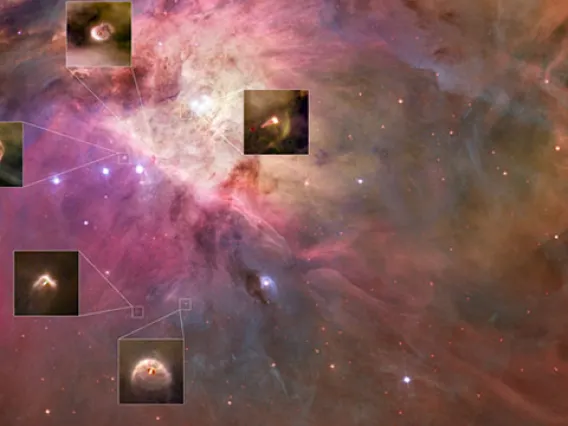
Planet-Forming Disks May Resemble Solar System 5 Billion Years Ago
By Emily Litvack, UAPlanet-Forming Disks May Resemble Solar System 5 Billion Years Ago
×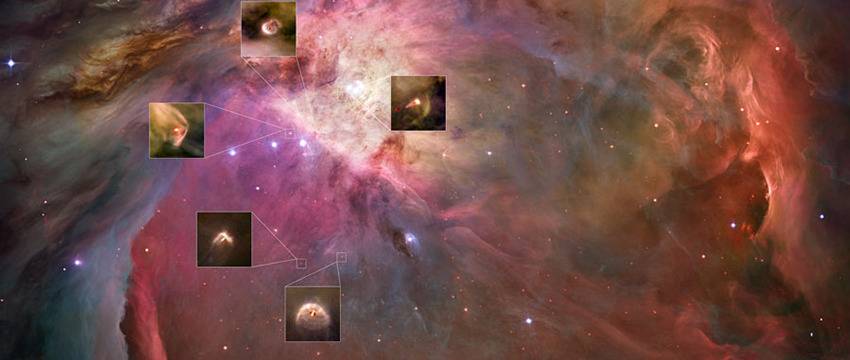
By Emily Litvack, UA Research, Discovery and Innovation - June 14, 2018
To make a planet, you need stuff.
Protoplanetary disks — cosmic frisbees of gas and dust orbiting young stars across the galaxy — spin out new planets. But the size of those planets depends on just how much material these disks have to give.
A team of scientists led by the University of Arizona has imaged a cluster of protoplanetary disks in the Orion Nebula and discovered that they are smaller than those previously studied in closer, less-dense regions. The smallness of these newly imaged disks suggests that making giant planets such as Jupiter (which is 2.5 times more massive than all the other planets in our solar system combined) could be especially difficult.
What's more, the Orion Nebula looks a lot like other planet-forming regions in the Milky Way, meaning our own solar system likely formed in an Orion-like environment. The team's findings have been published in the Astrophysical Journal.
The scientists used the largest telescope in the world, an interferometric array of radio telescopes in Chile called ALMA, to observe about 110 protoplanetary disks in the Orion Nebula in the deepest survey of the region yet.
"The general motivation for the whole field is that we want to understand more about how planets are formed," says Josh Eisner, a UA professor of astronomy who led the study.
In their pursuit of that understanding, scientists have spent decades looking to star-forming regions such as Taurus, a mere 500 light-years away (as compared to Orion's 1,344). While its nearby location makes a slice of the universe such as Taurus easier to observe with less-powerful telescopes, it's not what one might call a "typical" planet-forming region.
Orion, on the other hand, with its many stars (and orbiting disks) clustered together in relatively small area, is typical. It requires a more powerful telescope to take sharp observations, but in terms of regions where planets — or entire solar systems — form, it's a better model.
"Orion is not at all an oddball region. The disks there look a lot like what we think our solar system looked like when it was a protoplanetary disk," Eisner says. "And now with the advent of ALMA, we can study regions like Orion well."
Based on the images, the team — which also included astronomy and astrophysics graduate student Ryan Boyden, Steward Observatory postdoctoral researchers Nicholas Ballering and Min Fang, Steward Observatory associate astronomer Jinyoung Kim, and Lunar and Planetary Laboratory associate professor Ilaria Pascucci — was able to calculate the mass of protoplanetary disks in the Orion Nebula.
"Disk mass tells you how much stuff there is in the disk and that gives you a budget for what you can build out of it," Eisner says. "And what we found was, in this region, mass is actually quite constraining."
Unlike those studied in nearby regions such as Taurus, planet-forming disks in the Orion Nebula don't have enough stuff to build large planets such as Jupiter, for which you would need tens of Earth masses. According to Eisner, this may mean that much of the stuff already has been used to make young planets. Disks in Orion also appear smaller in size than those in Taurus-like regions.
"It's pretty tantalizing that Orion looks so different from all these lower-density, closer regions but it's just one. We want to fill in the data with more of these high-density regions to see if they all look like Orion," says Eisner, who is already seeking grant funding and telescope observing time to do so.
The discovery also will be tantalizing for those interested in what our solar system looked like as it was cooking some 5 billion years ago.
"The initial conditions for planet formation can tell us a lot about the constraints and how the process really unfolds," Eisner says.
One theory about our solar system's formation, called the Nice Model, argues that, early on, the configuration of the planets within a disk was small and compact until resonance finally flung Neptune and Uranus onto longer orbits.
The fact that the small, compact systems Eisner's team observed in the Orion's disks match up so nicely with the initial planetary configuration in the Nice Model, Eisner says, is a compelling hint at the origins of our solar system.
"The solar system probably formed in an Orion-like environment," he says. "Now we've actually got an idea of what systems there look like."
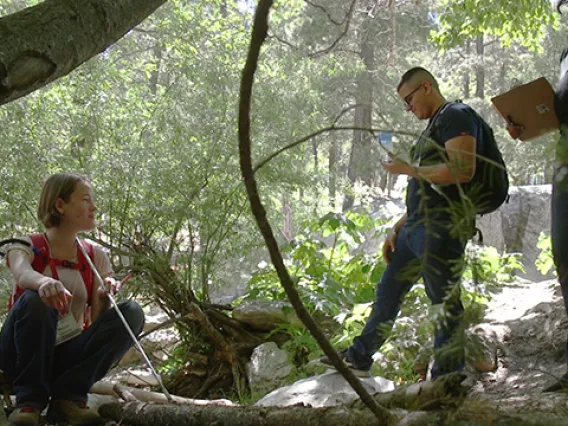
UA Encourages Visually Impaired Teens in STEM
By Alexis BlueUA Encourages Visually Impaired Teens in STEM
×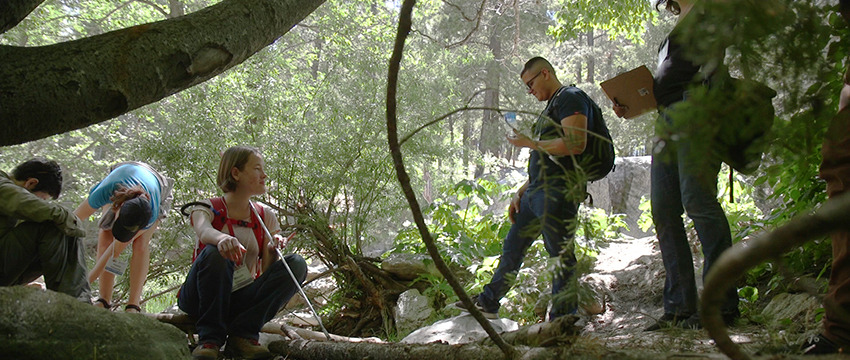
By Alexis Blue, University Communications - June 13, 2018
Maggie Lindsay's long, white cane swishes back and forth through the leaves, as she makes her way up the mountain slope with her fellow students. Tiny twigs snap beneath her sneakers. Trees rustle in a light breeze. Summer sunlight filters through the branches, warming her skin, as the sweet scents of soil and pine mix in the mountain air.
There's a lot for Lindsay's senses to take in on this warm June day — even though she can't see her surroundings.
Seated at a concrete picnic table amid a group of teenagers, 16-year-old Lindsay is handed a living butterfly. She gingerly touches its wings as the insect tiptoes across her knuckles.
"It's definitely still alive — it's crawling on my fingers," she says.
Next come beetles, spiders, dragonflies, ladybugs, wasps, bees — a mix of real insects and plastic models — passed from one student to the next so they can feel them with their hands.
Some, like Lindsay, can't see the insects at all, while others can make them out to some degree.
All of the students have gathered on Mount Lemmon to experience science through the University of Arizona's Project POEM, a National Science Foundation-funded project designed to introduce visually impaired middle and high school students to career possibilities in science, technology, engineering and math.
Project POEM Goes to SkySchool
Lindsay, who will be a junior at Veritas Preparatory Academy in Phoenix in the fall, is one of 10 visually impaired students, from across Arizona, taking part in the program, which kicked off this month with a weeklong stay at the UA's Mount Lemmon SkyCenter, north of Tucson.
There, the students participated in an adapted version of Sky School, a K-12 science education program based at the center.
They spent their first full day on the mountain handling insects, analyzing soil and testing water quality, under the guidance of UA student instructors. They also met with visually impaired working scientists.
The Sky School experience was the first phase of the 14-month Project POEM, which stands for Project-Based Learning Opportunities and Exploration of Mentorship for Students with Visual Impairments in STEM. The project is funded by an NSF grant of more than $1 million.
Lindsay — who is interested physics, biology, chemistry, and science and learning in general — was referred to the program by two of her teachers who work with students with visual impairments in Phoenix. The ever-inquisitive teen had plenty of compelling questions for her Sky School instructors, as she set out to soak up as much information as she could.
"I like learning things about the way the world works," Lindsay said. "And seeing how each little piece is connected to every other little piece to create this beautiful planet that we live on."
Lindsay wants to have a career in science one day. It's the goal of Project POEM principal investigator Sunggye Hong that she, and other young people with visual impairments, feel empowered to pursue that dream.
Underrepresentation in STEM
People with visual impairments often lack encouragement in STEM and remain highly underrepresented in STEM careers, said Hong, an associate professor in the Department of Disability and Psychoeducational Studies in the UA College of Education.
As a child growing up with visual impairment, Hong once thought of becoming a scientist himself, but wasn't encouraged to pursue it.
Now he wants to show students interested in STEM that visual impairment shouldn't be considered a barrier.
"The goal of this project was to break that ice and possibly come up with ways to motivate our own students — have them be equipped with the knowledge and ability and power to seek opportunities or become a scientist with visual impairment," Hong said.
In some cases, vision limitations might even give students a unique advantage in STEM, Hong said.
For example, Lindsay recalls learning about chemical reactions in a high school chemistry class. Since she couldn't see changes in color in lab experiments, she noticed things such as temperature and smell, which her sighted classmates did not.
"I think because the world we live in is so visual, sighted people tend to overlook those things, not on purpose, just because they use their eyes so much," she said. "Since I can't use my eyes, I had to find all the other ways I could do it, and I ended up learning, in some ways, more."
Playing to the UA's Strengths
Project POEM covers a variety of sciences, but it especially leverages two strengths of the UA: astronomy, which is typically thought of as a highly visual field, and the College of Education's training program for teachers of visually impaired students, which Hong oversees.
"We thought the synergistic power of combining these two areas of study would be great," Hong said.
Students were introduced to astronomy at the Sky Center, through telescope viewings augmented with sounds that fluctuate with light intensity.
They will continue learning about astronomy and planetary science in the next phase of the program, as they engage, throughout the coming school year, in a unique STEM curriculum developed by the Project POEM team. As part of the curriculum, students will receive 3-D models of real spacecraft and documented craters discovered in Arizona and on the surface of the moon and Mars.
Many of the models, which are designed to let students experience craters through touch, are based on data and images collected by the UA's Mars HiRISE camera. They're being cast in the lab of Project POEM co-principal investigator Steve Kortenkamp, an associate professor of practice in the UA's Department of Planetary Sciences and the Lunar and Planetary Laboratory.
The Project POEM students each will be paired with two mentors, with whom they will interact virtually — a UA student in a STEM major and a visually impaired professional who currently works in STEM. The industry mentors are located throughout the country and work in a range of disciplines, including oceanography, math, software engineering, biomedical engineering and organic chemistry.
The Project POEM team members hope their curriculum may eventually be adopted on a national scale.
Meanwhile, for students such as Lindsay, the project is helping to realize a dream for the future.
"I know that it's possible to do science being blind, because I know people who do that, but I don't really know how I would do that, so I want to learn," Lindsay said. "I also think that I, hopefully, will learn how to think about the world in a scientific way — as in, see problems and then think of ways to fix them. Or just be extra curious."
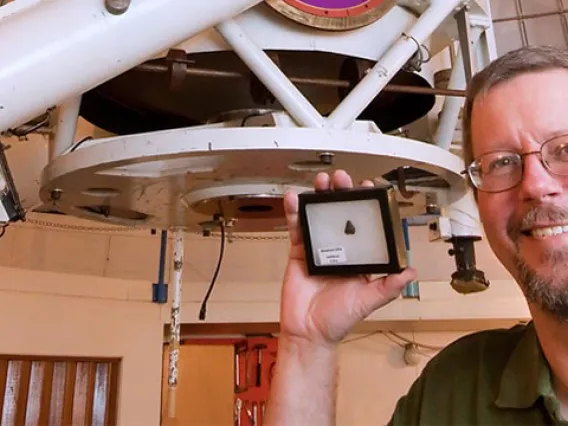
What it Takes to Discover Small Rocks in Space
By Daniel StolteWhat it Takes to Discover Small Rocks in Space
×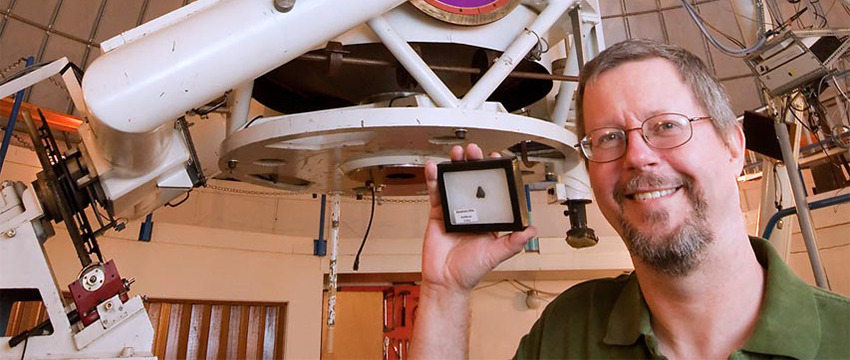
By Daniel Stolte, University Communications - June 6, 2018
Once every month, on average, somewhere on Earth a fireball appears out of nowhere and for mere seconds, casts a blinding flash across the sky before it blows up in a thunderous explosion. It happened last Saturday over southern Africa, where a small space rock disintegrated in the night sky and – possibly – scattered debris on the ground, awaiting discovery by meteorite hunters.
Despite their relative frequency, of all the small space rocks that have impacted Earth, only three have been spotted by telescopes during the final hours of their collision course with our planet. All of them happened to be discovered by the Catalina Sky Survey, or CSS, and coincidentally by the same man: Richard Kowalski. Kowalski is one of the CSS's senior research specialists and a 13-year veteran of the University of Arizona's Lunar and Planetary Laboratory.
The CSS is the only asteroid search program capable of detecting imminent small impactors, says director Eric Christensen. On June 2, 2018 LA registered as a pixelated smudge on the camera sensor of the UA's 60-inch survey telescope on Mt. Lemmon when it was roughly the same distance from Earth as the Moon. Less than nine hours later, the 6-foot bolide exploded in a ball of fire in the night sky over southern Africa.
"A key part of this sensitivity is processing the data immediately as it’s acquired, and having skilled observers like Richard review the data, and report and follow up anything new and potentially interesting," Christensen says. "Though our primary directive from NASA is to detect and track larger near-Earth objects, our survey is sensitive to smaller but closer asteroids as well."
Over the last 20 years, the CSS has discovered about 8,500 near-Earth objects, or nearly half the known NEO population, plus more than 100,000 non-hazardous Main Belt asteroids and hundreds of comets.
Why does the vast majority of small asteroids like 2018 LA go undetected?
Kowalski: The sky and the solar system are very large, and the field of view with our telescopes is small in comparison. That's why it takes about a whole month to scan the entire visible sky. Other limiting factors are the fact that Earth itself gets in the way, so you can only see certain parts of the sky depending on where you are. Also, daylight prevents us from detecting anything for half the time. The smallest asteroid we detected was about a meter across. But for such small bodies, the conditions have to be just right. You know how you sometimes spot a plane in the sky that's very far away, but because the sun hits it just right, you can see it glinting? Spotting small asteroids is very similar. The telescope has to be looking at the right point in the sky where the object happens to be just as it becomes bright enough to see it. Just due to their small size, many rocks slip through.
Can you walk us through the process that the Catalina Sky Survey uses to find near-Earth asteroids?
Kowalski: We work in a systematic manner; we try to cover the entire visible sky at least once a month with our 60-inch survey telescope on Mt. Lemmon, and at least four times a month with our 30-inch Schmidt Telescope on Mt. Bigelow, which has a wider field of view. Most of the system is automated. Each evening, we program the telescopes to follow a certain pattern. We take a 30-second exposure image of one part of the sky, then the telescope moves to an adjacent part, makes another exposure, and so on. After imaging 12 patches of sky in this manner, it goes back to the first field, and it goes through this sequence four times, spread out 40 minutes apart.
A specialized software gets rid of the stars in the image, looks for things that could be moving and presents those to the human observer sitting in the control room. The human eye-brain combination is better at pattern recognition, and that is why we have humans look at every image. Many of the objects flagged by the software are real asteroids, but some are artifacts caused by cosmic rays, very faint stars, satellites or electronic noise in the system. We look for all those things that don't look right and check them for consistent movement.
Before we start working every night, we download the database of all known asteroids. Once we find a signal that is a real object, we create a digest, which calculates the direction and the apparent motion in our image, and how much it deviates from the predicted movement of main belt asteroids between Mars and Jupiter. If we have a new discovery that shows it is not a known object, we send an email to the Minor Planet Center in Cambridge, Massachusetts, where colleagues will also do a number of checks. Once their computers go through those checks, the objects gets listed on the near-Earth object confirmation page, NEOCP, which anyone can access: it will tell them where to point their telescopes. The entire process, from the time something shows up on my screen to being published, only takes about 10 minutes.
How many new asteroids are discovered this way?
Kowalski: Our current rate of discovery can vary from one object per night to up to 20. Our record for a single night is somewhere around 30. My personal record is 21 in one night. That was just a few weeks ago. With our new cameras, we cover so much of the sky and we are so efficient at the process that we typically average anywhere between eight to 10 per night, which range in size from 1-2 meters up to as much as a kilometer in diameter. But the larger ones are quite rare. Most average from 10 to 50 meters, and nearly all of those are harmless — they won't hit the Earth at any time soon.
Speaking of risk, how dangerous are small asteroids like 2018 LA?
Kowalski: In the case of a small body like 2018 LA, we know that if it drops meteorites, they're going to be small pieces, fist-sized down to pebbles, and the rest turns into dust and vapor. In the grand scheme of things, asteroids in that category put on a light show, but they're not dangerous in any way. As the object slams into the atmosphere, the rock is slowing down so rapidly that the back is traveling faster than the front and the pressures get too high for the material to remain intact. That's why they explode as fire balls. There is a lot of energy output because of their speed and the resulting friction.
What determines whether an asteroid will burn up in the atmosphere or fall to the ground?
Kowalski: In short: direction, velocity and what it's made of. Also, the object's trajectory: If it hits Earth head-on, it is likely to be moving very fast, tens of kilometers per second. Those objects are much less likely to survive the entry unless they are very large. On the other hand, if an asteroid is catching up to the Earth from behind, it could come in very slowly, and therefore could be smaller and still reach the surface. Some meteorites are very brittle, and those tend to go up in vapor and dust very easily, while others literally are cores of iron from another asteroid. Those have much better chance of reaching the ground.
How much do you know about an asteroid once you have discovered it?
Kowalski: We don't do any physical properties assessment. When we discover near-Earth objects, we only point them out so other groups and amateurs can make follow-up observations to find out, for example, how fast they're rotating, what they are made of and things like that. Every once in a while, you'll hear conspiracy theorists say we would deliberately not tell the public if we discovered a large and potentially hazardous impactor on a collision course with Earth. The truth is, every object looks essentially the same, it's just a grey dot on the screen to me. I'm not in any way knowledgeable if it's going to hit, or what it's made of, etc. The very process of discovering these objects and the short time ensure that the information gets out immediately. We want the public involved, and we want to reach as many people with telescopes as possible, because the more follow-up observations we can spread out over the time, the more accurately we can predict where those things may come down.
How did you find out that with 2018 LA, you had discovered another asteroid that ended up impacting Earth?
Kowalski: I typically work until dawn, and I don't sleep very well on the mountain, so I commute home every morning. I didn't know it would impact until I woke up the next morning. Quite often I'm the last to know. Our team of observers is doing the same job — looking for these impacting asteroids — so discovering them is not a big surprise. What was a big surprise was the fact that I happened to be the one who discovered all three observed impactors. My wife suggested I treat myself to a large T-bone steak that day to celebrate, and that's what I did.
